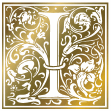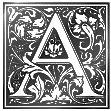- Old Testament
- Matthew
- Mark
- Luke
- John
- Acts
- Romans
- 1 Corinthians
- 2 Corinthians
- Galatians
- Ephesians
- Philippians
- Colossians
- 1 Thessalonians
- 2 Thessalonians
- 1 Timothy
- 2 Timothy
- Titus
- Philemon
- Hebrews
- James
- 1 Peter
- 2 Peter
- 1 John
- 2 John
- 3 John
- Jude
- Revelation
- Old Testament
King James Bible 1611 Typography
 s the original 1611 King James Bible too hard to read?
Many people who have had the opportunity to see a copy of 1611 Bible have found it hard to read and invariably
complain about the gothic font. However, it is not just the font that seems alien, but also the use of
historical typographic letterforms, as well as the Elizabethan spelling of words.
s the original 1611 King James Bible too hard to read?
Many people who have had the opportunity to see a copy of 1611 Bible have found it hard to read and invariably
complain about the gothic font. However, it is not just the font that seems alien, but also the use of
historical typographic letterforms, as well as the Elizabethan spelling of words.
For this reason the Blackletter edition presented here, does not include all the typographic representations found in the original. The purpose of this edition is to give the reader a feel for the original 1611 King James Bible and make it as easy to read as possible.
The 1611 King James Bible used the gothic Blackletter type to present the biblical text, but it also used roman type not just for its chapter headings but for its running titles and chapter summaries, and italic type for its marginal commentaries. Additionally, the printers occasionally interposed roman type within the gothic portions of text to signify words added by the translators that are not found in their original sources but were nevertheless deemed necessary to help clarify the meaning of the text.
An example in the original 1611 King James Bible typograhy
 ND it came to paſſe in those
dayes, * when there was no King in Jſrael, that there was a certaine Leuite ſoiourning
on the ſide of mount Ephraim, who tooke to him † a concubine out of Bethlehem Judah. ND it came to paſſe in those
dayes, * when there was no King in Jſrael, that there was a certaine Leuite ſoiourning
on the ſide of mount Ephraim, who tooke to him † a concubine out of Bethlehem Judah.
|
The Blackletter Edition
 nd it
came to passe in those dayes, when there was no King in Israel, that there was a certaine Leuite soiourning
on the side of mount Ephraim, who tooke to him a concubine out of Bethlehem Judah. nd it
came to passe in those dayes, when there was no King in Israel, that there was a certaine Leuite soiourning
on the side of mount Ephraim, who tooke to him a concubine out of Bethlehem Judah.
|
As can be seen in these examples, the differences are subtle, but they are enough to clarify the text for a modern reader, while still giving the look and feel of the original. Some of the typographic letterforms not included in this edition are described below:
Why do some of the letters look strange?
There are definately aspects of the typography that stand out to modern eyes. Most noticeable of these is the use of the 'long s', visually resembling a modern 'f' (as in the word 'Goſpel'). The modern form of the letter 's' was only used at the end of words, and in a few other specific circumstances. The 'long s' persisted in English print until the late 1700s, and survives in mathematics today as the symbol to denote an integral.
Other striking features include: that the letter 'j' had not yet fully grown away from 'i' ('Iohn' vs. 'John'); the letter 'v' had not developed from 'u' ('euery' for 'every'); and that there are two alternative forms of the lower-case 'r', selected in the Bible according to no clear or consistently used definition.
The Long and Short 's'
The long 's' (ſ) is an archaic form of the lower case letter 's'. It replaced a single s, or the first in a double s, at the beginning or in the middle of a word (e.g. "ſinfulneſs" for "sinfulness" and "ſucceſsful" for "successful"), and in ligature form (e.g. "Tiſſick" for "Tissick"). The modern letterform is known as the short s.
The long s was derived from the old Roman cursive s in the middle of words. When the distinction between majuscule (uppercase) and minuscule (lowercase) letter forms became established, toward the end of the eighth century, it developed a more vertical form.
Typographic Ligatures
In writing and typography, a ligature occurs where two or more letters are joined as a single character. An example is the character æ as used in English, in which the letters a and e are joined. The common ampersand (&) developed from a ligature in which the handwritten Latin letters e and t (spelling et, from the Latin for "and") were joined together.
The R rotunda
The r rotunda (ꝛ), "rounded r", is a historical calligraphic variant of the minuscule (lowercase) letter Latin r used in full script-like typefaces, especially in Blackletter fonts. An example in the 1611 can be found in John 1:15 where the word preferred is typeset as pꝛeferred.
Unlike other letter variants such as the 'long s', which were originally seen as orthographically distinctive, R rotunda has always been a calligraphic variant, used when the letter r followed a letter with a rounded stroke towards the right side, such as o, b, p, h (and d in typefaces where this letter has no vertical stroke, as in ∂, ð). In this way, it is comparable to numerous other special types used for ligatures or conjoined letters in early modern typesetting.
From Blackletter to Roman Type
When the King James Bible was first printed in 1611, English printing still followed the blackletter tradition inherited from earlier centuries. This typeface, with its ornate and angular strokes, was visually impressive but could be difficult for modern readers to distinguish—especially the “long s” (ſ), which closely resembled the letter “f.” The blackletter style reflected the visual conventions of early English Bibles, such as those of Tyndale and the Great Bible, and was familiar to readers of the early seventeenth century.
As printing technology advanced, English publishers gradually adopted the Roman typeface, which had already become the standard for scholarly and classical works. Roman type offered cleaner lines and greater legibility, allowing the sacred text to be read with less visual strain. During the eighteenth century, this change was consolidated in the major updates of the King James Bible—first in the 1762 Cambridge edition and then in the 1769 Oxford edition prepared by Dr. Benjamin Blayney. These editions also standardized spelling, punctuation, and italics, giving the text the more modern appearance we recognize today.
Thus, while the words of the King James Bible remained the same, its presentation evolved. The shift from blackletter to Roman type did not alter Scripture itself but reflected the maturing of English typography. This transition allowed future generations to read the same text more easily, preserving its dignity while enhancing its clarity.
Conclusion
While the Blackletter edition is not an exact representation of the original typesetting of this historical work, it is hopeful that it will open the door for many readers to experience the origins of the most famous book ever printed in the English language. Over 6 Billion copies of the King James Bible have been typeset and printed since it was first published over 400 years ago.
Only you the reader will know whether we have achieved our goal to make the 1611 King James Bible accessible and as easy to read as possible. May God bless your efforts in doing so.
